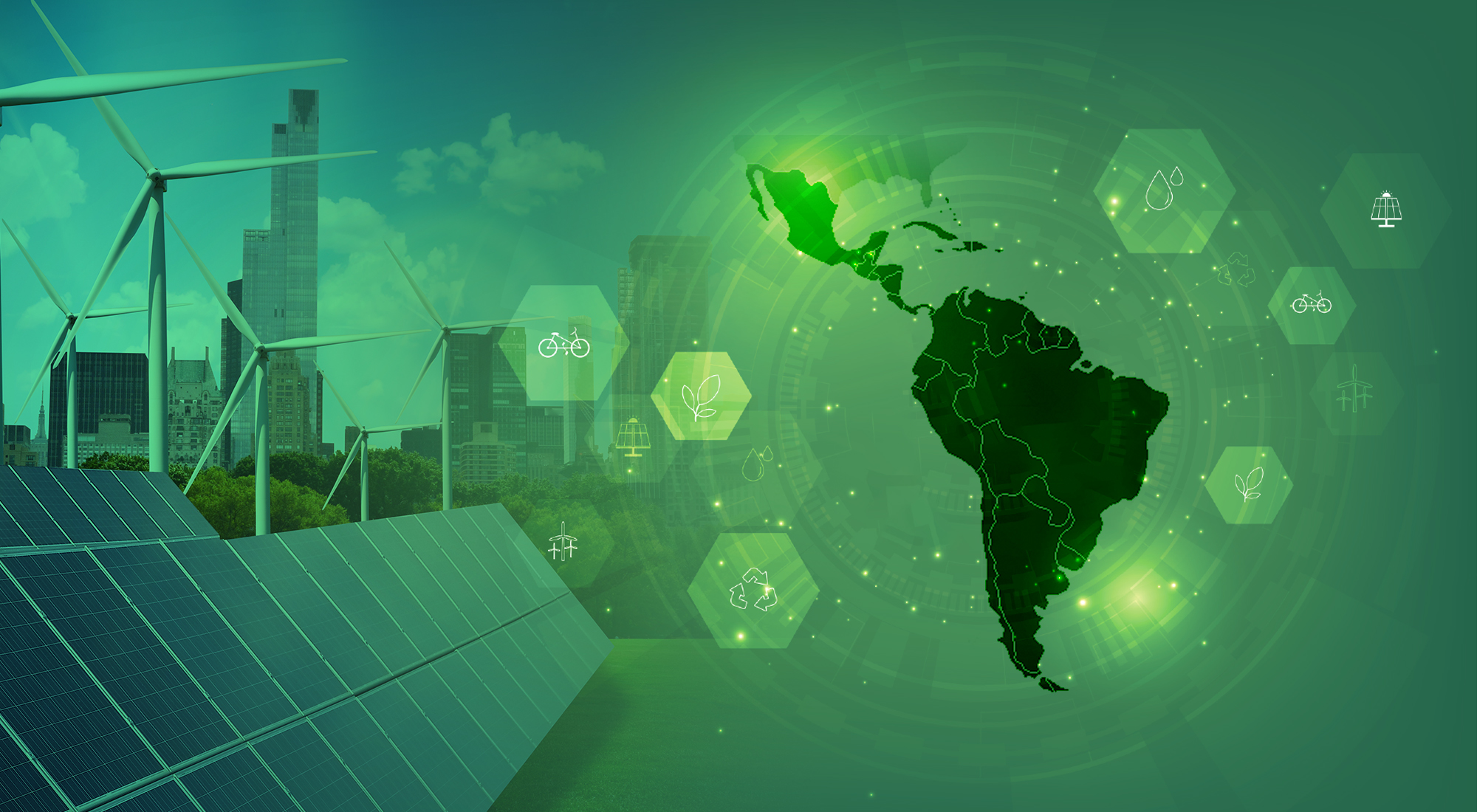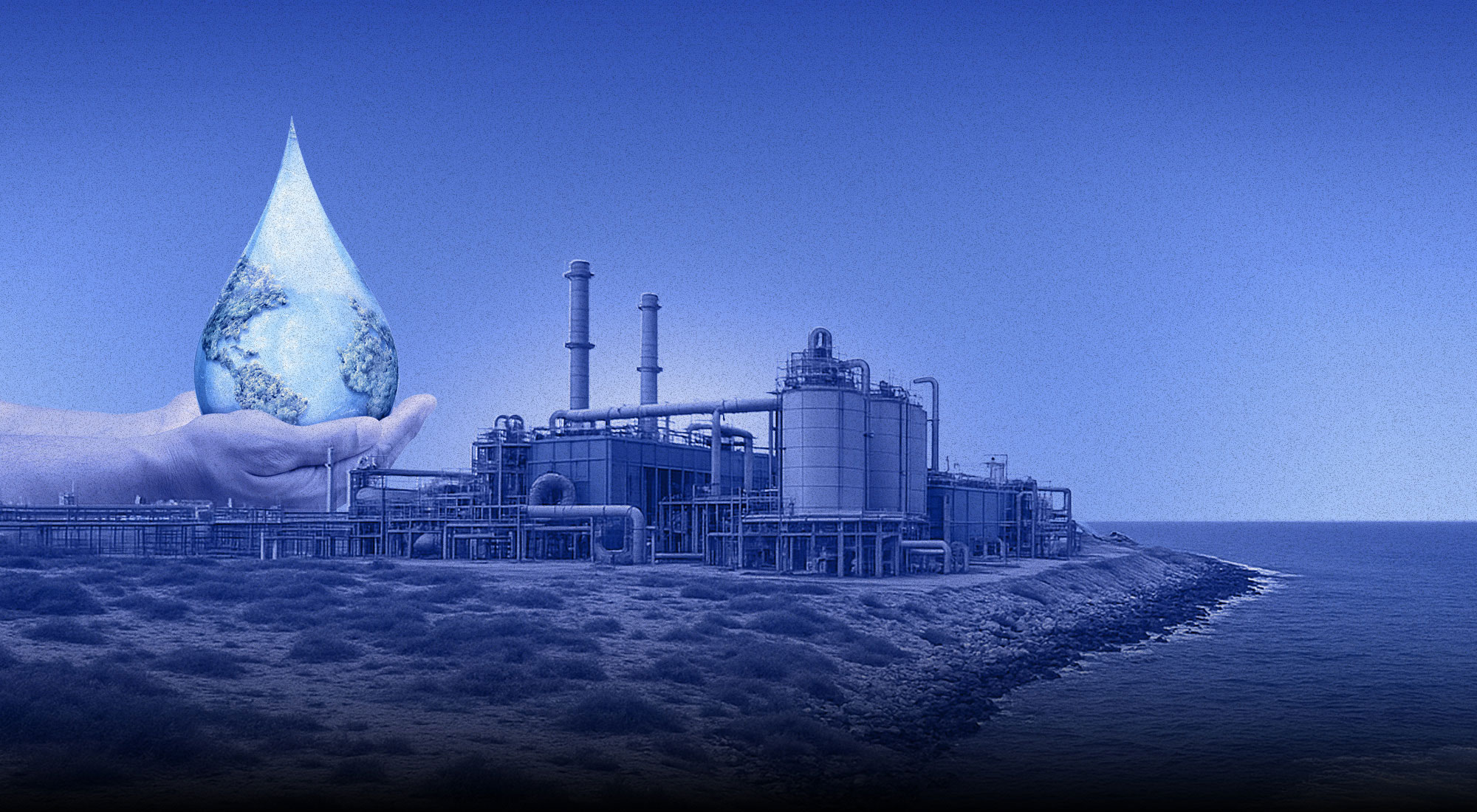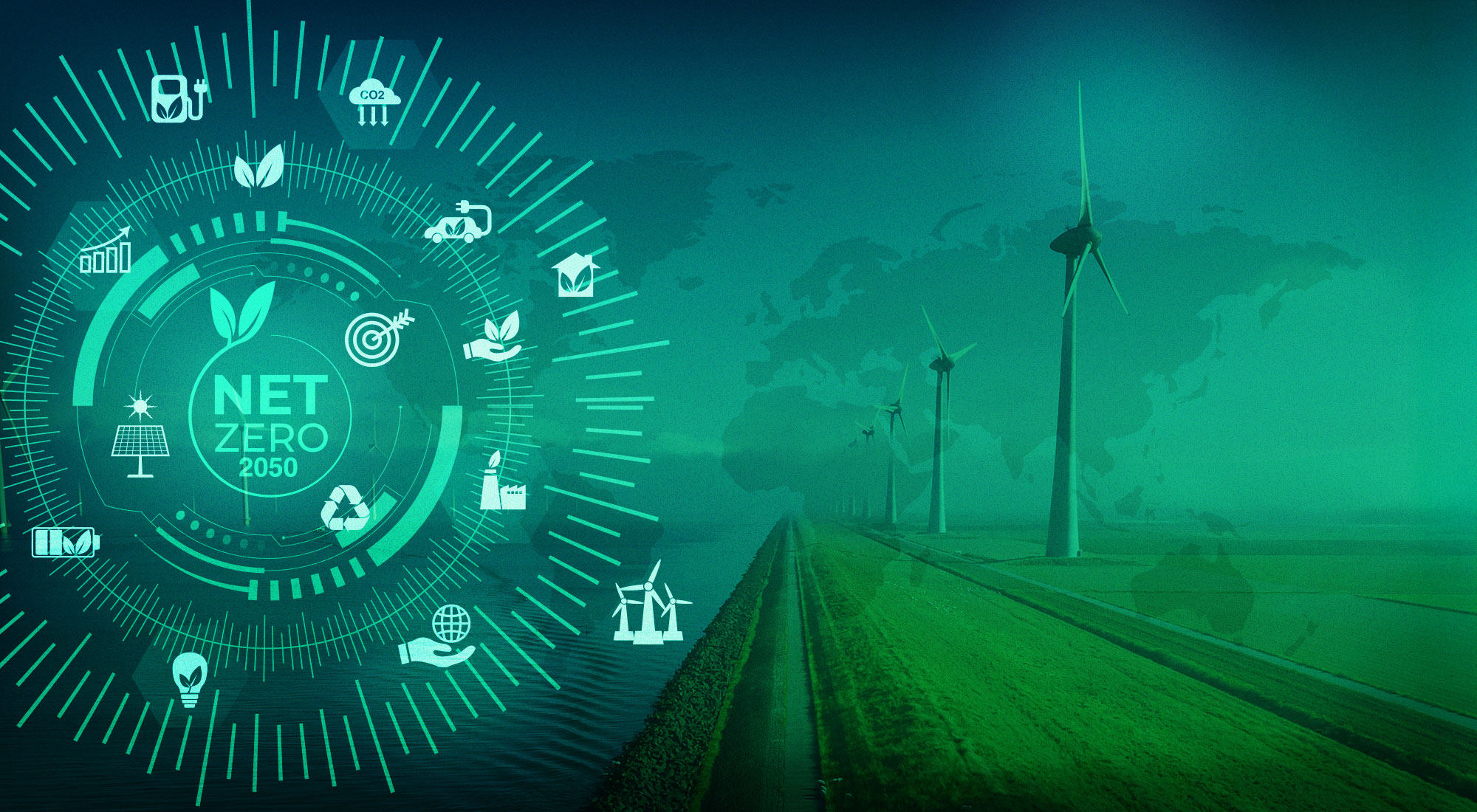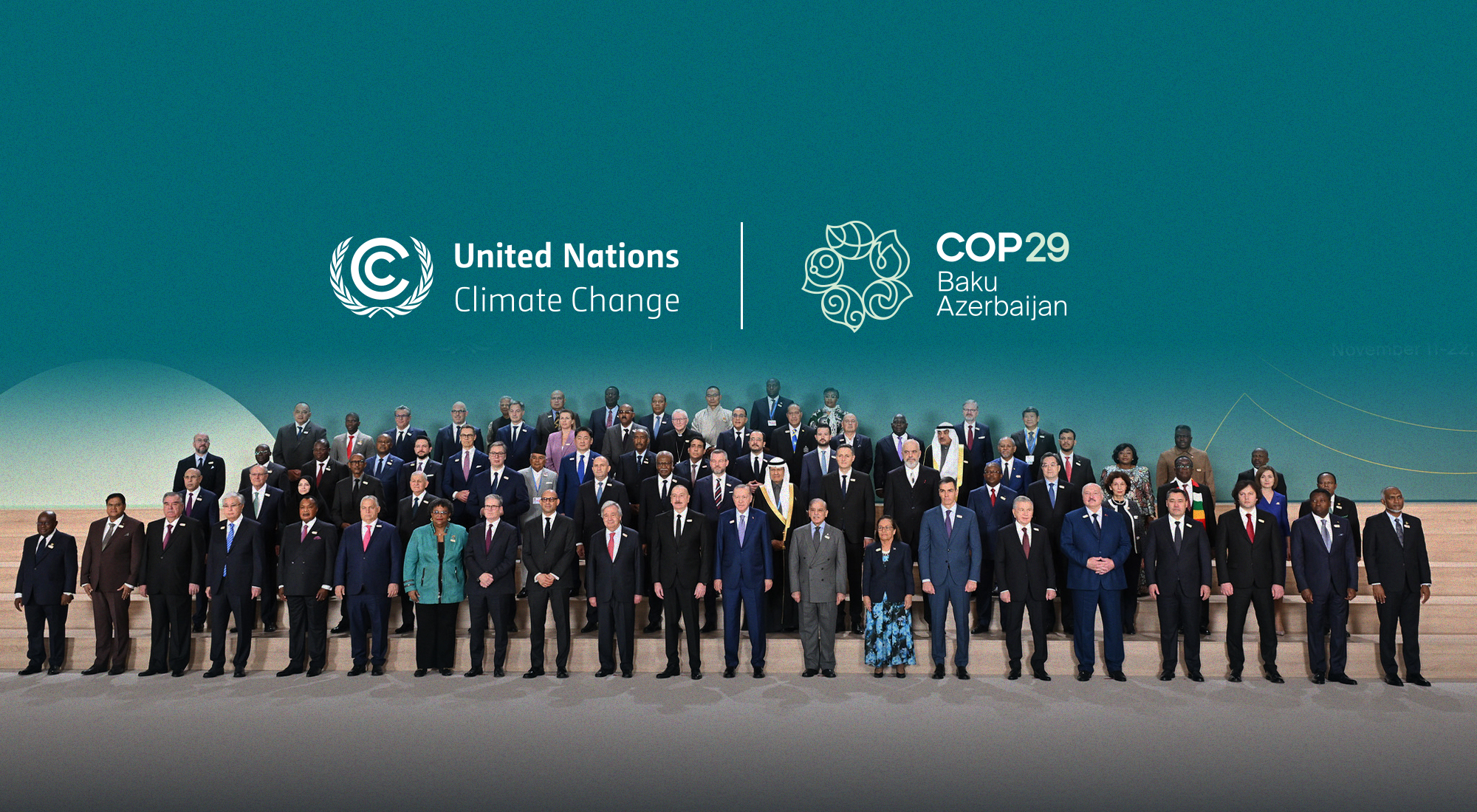Latin America and
Caribbean in a “boiling world”
During COVID-19 crisis, UN Secretary-General António Guterres made a bold and alarming argument: the continuation of greenhouse gas emissions would spell catastrophe and lead to planetary climate disruption.[1] More recently, he argued that the “era of global warming has ended; the era of global boiling has arrived”.[2] This pressing issue is no stranger to Latin America and the Caribbean (LAC), a region known for its vast political, economic, social, and cultural diversity yet remaining a developing area where there is still no high-income economy and economic stagnation and socioeconomic backwardness are still dominant agenda issues.
One cannot overlook the significant challenges that Latin America and the Caribbean face, with inequality and poverty being the most prominent ones. Despite some progress in reducing poverty in the last two decades, the region still grapples with the highest level of inequality worldwide[3] and economic growth has been almost non-existent in the 2012-2022 period, another “lost decade” as in the 1980s. This has been putting pressure on the state’s limited resources, affecting essential services and job opportunities, and broadening the marginalization of vulnerable groups.
Adding to the region’s predicament are the global challenges posed by climate change, the need for economic decarbonization, the emergence of the fourth industrial revolution, and the consequences of the Russo-Ukrainian war. However, in the long term, climate change threatens to exacerbate the region’s vulnerability to natural disasters such as hurricanes, droughts, and floods, which can have devastating effects on local economies and foster climate-induced migration. Global economic decarbonization, though necessary to combat climate change, poses challenges for a region that heavily relies on fossil fuel exports. Here lies the significant paradox between economic development and the choice for a green economy. Finally, the region faces significant vulnerabilities in providing basic public goods and services, such as healthcare, education, and infrastructure. These vulnerabilities have become even more apparent with the COVID-19 pandemic, which has tested healthcare systems and exacerbated existing inequalities.
According to Walter Leal Filho and Franziska Wolf, there are a series of deficiencies that intensify vulnerability to climate change, including endemic poverty, limited access to capital and global markets, continuous ecosystem degradation, unplanned urbanization, and limited personal and institutional capacity to address environmental problems, among others.[4] LAC confronts a series of challenges that require comprehensive and sustainable solutions to ensure equitable and resilient development.
To address these pressing challenges, the region requires comprehensive and sustainable solutions that promote equitable and resilient development. The research paper addresses the Latin American and Caribbean perspective(s) on climate change and aims to address three overarching questions: How does climate change affect LAC, and vice versa? How do Latin American and Caribbean countries cooperate (or not) to tackle climate change? How are key regional nations responding to climate change?
As the upcoming 2023 UN Climate Change Conference in the United Arab Emirates comes closer, the paper presents the trajectory of Latin America and the Caribbean in climate change negotiations and presents the unsolved challenge of how to balance economic development and climate change action commitment. Despite increasing national environmental policies and regional convergence, the region still struggles to achieve high levels of commitment due to the tension between climate change adaptation and mitigation policies and economic development objectives.
Accelerating social
vulnerability: LAC faces climate change
Climate change is a pressing issue and a strategic challenge for the LAC future, and the bulk of the region is committed to the global effort to limit global warming below 2ºC under the Paris Agreement. The World Meteorological Organization’s 2022 report on the state of the climate in LAC reveals a long-term warming trend, accelerated sea level rise, and a vicious cycle linking drought, reduced hydroelectricity production, and increased hydrocarbon demand.[5] The Sixth Assessment Report (AR6) produced by the Intergovernmental Panel on Climate Change argues that in Central and South America, climate change disproportionately affects the most vulnerable populations “without rapid, deep and sustained mitigation and accelerated adaptation actions, losses and damages”.[6] LAC is home to seven of the world’s most biodiverse countries, accounting for 40% of global biodiversity. Despite representing only 8% of the world’s population and 6% of its GDP, the region contributes around 8% of global greenhouse gas emissions, with agriculture and forestry being the main emission sectors.[7]
LAC is a diverse region in terms of vulnerability, emission profiles and governmental responses to climate change. In general, vulnerability to climate change is high, with potential costs estimated at around US$100 billion annually by 2050[8], while the adaptation economic cost would vary between US$16.8 and US$21.5 billion per year up to 2050 (around 0,3% of the overall LAC GDP)[9]. More than 50% of LAC citizens belong to countries with “high” to “extreme” risks, while only a few countries are considered “low” on the risk scale, such as Uruguay and Chile.[10] The region’s main emitters are Argentina, Colombia, Brazil, Mexico, and Venezuela, which together account for more than 70% of LAC’s total emissions, with Brazil and Mexico contributing more than half of regional emissions.[11]
At the same time, LAC is not a homogeneous geographic and climatic region. It possesses strong regional differences, from Argentina’s temperate Pampas to the tropical Caribbean islands. The impacts of climate change vary across the region, with the Caribbean, Central America, and the Andean region being the most exposed. These areas face altered precipitation patterns, extreme temperatures, sea-level rise, glacier disappearance, and an increased frequency of extreme climate events, all of which will have long-term impacts on regional climate and overall development.[12]
The Economic Commission for Latin America and the Caribbean (ECLAC) identifies agriculture, water, biodiversity and forests, health, tourism, and poverty as the main areas of potential impact and risk from climate change,[13] while a recent World Bank report on LAC warns that climate change is increasing the frequency and intensity of extreme weather events, disrupting transport and energy systems, and negatively affecting productivity across various sectors.[14] Finally, climate change also poses a serious threat to urban areas, poor farmers, and rural communities in the region, many of whom live in remote areas with limited natural resources, communication and transportation networks, and weak governance systems.[15]
Amazonas is a critical feature of Latin America’s commitment toward climate change mitigation. The region has a critical role to play in limiting deforestation, particularly in that enormous ecosystem.[16] However, large-scale extractive activities such as mining, deforestation, grazing, and extensive cattle ranching pose significant environmental threats. These activities are central to local development and national prosperity in many countries, but illegal and unregulated activities by criminal groups present additional challenges, posing risks to both the environment and sustainable development.[17] The LAC region faces significant challenges due to climate change, but it also has a crucial role to play in mitigating its impacts. Addressing these challenges will require a comprehensive approach that considers the complex interactions between development, security, and climate change. Regional cooperation, adaptation and mitigation are three ways in which the region is facing global environmental changes.
The development-climate
change nexus in Latin America and the Caribbean
There is an increasing awareness about climate change’s effects in Latin American public opinion, but the backing for climate action is inconsistent across the region, while the levels of support for climate change action are lower than in the Global North.[18] This inconsistency can also be found in regional collective action vis-à-vis climate change global negotiations and forums. Even though the Paris Agreement has been signed by all LAC countries and the 2030 Agenda for Sustainable Development is a relevant feature for public policy in the environmental sector, there have been different approaches on how to face global warming and the responsibility of developing countries in that regard.
The “development-climate change nexus” is central to understanding Latin American perspectives – and other Global South regions such as sub-Saharan Africa[19] – on global warming since, on one side, actions taken to achieve development goals can also have significant implications for the environment and contribute to climate change actions, while, on the other side, climate change adaptation and mitigation actions can hinder development efforts. The region’s economic structure has long relied on the production and export of primary products like minerals, agricultural goods, and hydrocarbons. This dependence on primary products and short-sighted industrial policies have left the region highly susceptible to fluctuations in international markets, leading to economic instability. The rise of China only reinforces a new stage of reprimarization of the productive structure, thus reproducing a central-peripheral logic.[20] In this context, the negative impacts of climate change, such as shifts in rainfall patterns and temperatures and extreme meteorological events such as droughts, have added to their vulnerability.
As a developing region characterized by limited and later industrialization, most of the countries emphasize the “historical responsibility” of developed countries on the human activity causes of climate change due to their historical greenhouse gas (GHG) emissions and industrial activities, which add to their higher per capita emissions and their moral obligation to provide climate funds to developing countries to help in their mitigation and adaptation actions.
At the same time, the region has endorsed the “principle of equity and common but differentiated responsibilities and respective capabilities” (CBDR-RC) adopted in the Paris Agreement’s preamble. Another critical element of the nexus is the need for international cooperation. Due to the financial constraints and technological underdevelopment vis-à-vis the global north, most of the countries called for fair multilateral agreements, considering the disadvantages of developing economies, asking for creative solutions in terms of climate finance, and making a call for technology transfer in areas such as renewable energy or the green economy. Climate change finance is channelized in LAC through three main actors: those that are involved in the UNFCCC, those that operate through other international organizations and a diverse group of non-IGO actors that involve transnational and private endeavors.[21]
An interesting but failed project was Ecuador’s Yasuní-ITT Initiative, which aims to conserve biodiversity and indigenous people from oil exploitation. In 2007, the then Ecuadorian President Rafael Correa presented a proposal to not drill oil in one sector of the Yasuní National Park in return for 3.6 billion funding from international donors, but the external funding did not cover that number and the government withdrew the initiative, authorized the oil exploitation, and assigned licenses to a China National Petroleum Corporation (CNPC) subsidiary company to conduct drilling activities in the ITT zone despite public criticism.
Breaking fragmentation?
LAC cooperation dilemma on climate change
Despite general agreements on the place of LAC in the global climate change governance heterogeneity has been the rule in regional positioning vis-à-vis climate change negotiations in which the main divergences are on the type and intensity of national and regional responses to climate change. LAC usually offered a fragmented approach during the climate change negotiations. As Marzano Franco argues:
“LAC is not represented as a single block in the multilateral climate negotiations. On the contrary, there are several Latin American groups with divergent proposals such as ALBA (the Bolivarian Alliance for the People of Our America, composed by Bolivia, Ecuador, Cuba, Nicaragua and Venezuela) and AILAC (the Independent Association of Latin America and the Caribbean, with Chile, Costa Rica, Colombia, Guatemala, Panama, Peru and Paraguay). While ALBA members emphasize industrialized countries’ responsibility for global warming, AILAC presents itself as a “third way” within the North-South discussion, declaring that countries do not have to dismantle existing environmental legislation or weaken incipient climate policies in order to ensure prosperity.”[22]
Until recently, the Latin American and Caribbean bloc had been divided into three main groups. First, the majority of the regional states belong to the main coalition of developing nations, the Group of 77 (G77+China) at the United Nations, where the north-south economic divide continues to be important and shapes a crucial distinction between those developed industrial countries that are responsible for half of current greenhouse gas emissions, in addition to their “historical responsibility,” as well as conditionating the development agenda of the underdeveloped countries based on environmental arguments.
Second, some countries, such as Brazil or Mexico, belong to another transnational interest groups such as the OECD group (like Mexico) or the BASIC bloc (Brazil, South Africa, India, and China), which aims to represent a group of emerging economies that are becoming high-carbon emitting nations as a process of late industrialization, or the Alliance of Small Island States (AOSIS) in which most of the Caribbean countries participate.
Third, there are also intraregional groups within Latin America, such as the most radical Alliance for the Peoples of Our Americas (ALBA) and the equilibrist Independent Association of Latin America and the Caribbean (AILAC), which present themselves as an intermediate way to climate change negotiations beyond the develop-developing divide and ready to independently adopt voluntary emission reduction pledges. As Guy Edwards and Timmons Roberts argue, a “lack of a unified voice is underscored by the inconsistencies between the promises made and actual actions taken by Latin American governments to ameliorate the effects of global warming.”[23]
However, fragmentation has been complemented by a tradition of regional collaboration and cooperation, in addition to two major breakthroughs in the last few years: the Escazú Agreement and the coordinated position of CELAC toward COP27. First, Latin America has the oldest regional environmental-related official institution in Latin America and the Global South: the Forum of Ministers of the Environment of Latin America and the Caribbean, established in 1982. For years, it has been the most relevant space for political dialogue and collaboration on environmental issues in the region. Among the main roles of the Forum are an institutional space to discuss and set priorities for environmental action and a regional instance to agree on common positions regarding the United Nations Environment Assembly and the Forum of the Countries of Latin America and the Caribbean on Sustainable Development.[24]
The next Forum Meeting of Ministers of Environment of Latin America and the Caribbean will be held in Panama at the end of October 2023 with the participation of both presidencies of the previous COP 27 (Egypt) and the upcoming COP 28 (United Arab Emirates). The main regional concerns on the next COP28 were already presented during the Bureau Meeting of the XXIII Forum of Ministers of Environment of Latin America and the Caribbean held in Costa Rica, where LAC representative members called for more attention to the region, in addition to finding financial solutions to support climate change mitigation efforts, such as the Colombia’s call for working in multilateral cooperation programs or the debt-for-environment swap proposal by Argentina, among others.[25]
Second, the Escazú Agreement is a milestone for environmental governance and human rights in Latin America and the Caribbean. Its comprehensive scope addresses the interconnected issues of transparency, civic participation, justice and the protection of environmental defenders. LAC pushed for the adoption of the Escazú Agreement (or Regional Agreement on Access to Information, Public Participation, and Justice in Environmental Matters for Latin America and the Caribbean) grounded in the commitments agreed at the Rio+20 summit in 2012. Signed in March 2018, this agreement was a turning point for LAC collective agency since it is the first regional-led commitment on environmental issues in which the main goal is to guarantee access to environmental information, civil society participation in environmental decisions, and access to justice in this area.[26]
The inclusive negotiation process itself was groundbreaking not only because it was open to all regional states but also because the participatory process involved civil society organizations at national and regional levels. Also, it promotes people’s right to a healthy environment by improving access to information and transparency around environmental impacts. For example, it requires governments to produce public reports on environmental quality and publish environmental impact assessments. Additionally, it is the first world juridical instrument that contains a legal framework “for individuals and organizations that defend human rights in environmental matters.”[27] By protecting civil society groups and establishing mechanisms for public participation, the agreement aims to prevent conflict over development projects. This sets an important precedent globally. Even if the agreement has been opened to the 33 countries of Latin America and the Caribbean, there is still a long way to go before full implementation. Even if it came into force after 12 countries ratified it in April 2021, 16 countries still did not do it, including Brazil and Perú[28].
Third, the major intergovernmental mechanism for high-level dialogue and political cooperation in the region, the Community of Latin American and Caribbean States (CELAC), presented a joint proposal on climate change at Sharm el-Sheikh’s Conference of the Parties to the United Nations Framework Convention on Climate Change (COP27). The CELAC presented a unified position based on a consensus document in which they underlined that they recognize the “principles of equity and common but differentiated responsibilities between developed and developing countries to face the climate crisis”, asked for “a greater provision of public resources by developed countries to developing countries,” and criticized unilateral trade measures that may “constitute an arbitrary or restrictive means disguised to international trade” by using environmental arguments.[29]
The document particuarly underlined “the need for financing and to strengthen the role of GRULAC (the Latin American and Caribbean Group at the United Nations) in climate negotiations.”[30] The road toward a joint position was not easy. On one side, Brazil did not sign the declaration since it withdrew from CELAC under Bolsonaro’s government. The then presidential candidate and now Brazilian President, Lula da Silva, participated unofficially in the COP27 with a pro-environmental discourse more in line with the CELAC guidelines than the own Brazilian government. On the other side, even if the joint declaration shows a broader attachment to the north-south development divide with a strong call for additional efforts by the developed nations, it demonstrates a lack of specific commitment on how to mitigate climate change from the regional efforts. At the end of the road, the way the LAC countries are dealing with climate change shows a wide array of national strategies, commitments, and actions in their contributions to climate change adaptation and mitigation.
One climate change, different
LAC national responses
Despite the growing
convergence in the general LAC approach toward climate change, the differences
show up when individual nations present their nationally determined
contributions (INDC) in transition to low-carbon or carbon-neutral economies. A
key determinant of national environmental policies are political coalitions
since liberal (center-right) or progressive (center-left) coalitions seem to be
more prone to advance a ‘green agenda,’ as in the case of the new ‘pink tide’
with the arrivals of Argentine President Alberto Fernandez, Colombian President
Gustavo Petro, Chilean President Gabriel Boris, and lately the return of the
Worker’s Party leader Luiz Inácio Lula da Silva to the Brazilian Presidency.
The Amazon itself illustrates the scale of the impact of climate change on the region since it is a vital component of the Earth’s system since it contains the greatest diversity of terrestrial organisms on the planet, exchanges large volumes of water and energy with the atmosphere, affects local and regional climate, and is an important reservoir for carbon. If properly fitted, the Amazon’s hydrological mechanism plays a key role in maintaining global and regional climate.[31] However, the national authority’s response to the Amazon challenge was at least sinuous, not to say contradictory.
On the one hand, right-wing President Bolsonaro (2019-2022) denied that Amazon is the heritage of humankind after criticizing satellite data from its own government’s National Space Research Institute (INPE) that pointed to a rise in deforestation[32] whose rates during his term seemed to increase almost 60%.[33] On the contrary, his political rival supports a friendly environmental agenda from the 2022 political campaign that focuses on climate change action and fighting against deforestation. As an example, at the opening of the 26th Meeting of the São Paulo Forum in Brasília, Brazilian President Lula da Silva voiced his aim to push for a unified position of the eight Amazon countries (Bolivia, Brazil, Colombia, Ecuador, Guyana, Peru, Suriname, and Venezuela) for the upcoming United Nations Climate Change Conference (COP 28), to be held in the United Arab Emirates in 2023.[34] Brazil hosted the high-level meeting of the Amazon Cooperation Treaty Organization (ACTO), which focused on “attract investment, fight deforestation, protect indigenous communities and encourage sustainable development.”[35]
Additionally, Brasilia is planning to present a comprehensive green energy plan that would encompass multiple areas, including education, research and development, and infrastructure, among others, in order to decarbonize the economy and achieve the climate neutrality goals,[36] which means that Brazil’s nationally determined contribution aims to reduce GHG emissions by half below 2005 levels by 2030.[37] For both domestic and international agendas, Lula’s Brazil is looking for international investors to complement and boost internal efforts for an ambitious greenhouse gas emission reduction. However, Lula’s renewed diplomatic activism and environmental commitment at home need to deal with different national perspectives and a legacy of regional unwillingness to set common positions, even in the same (environmental) region.
Beyond Brazil, the climate change action balance is far from being positive. According to the Climate Action Tracker (CAT), most of the LAC national efforts are characterized as insufficient, while the Argentinean and Mexican cases are presented as highly and critically insufficient, respectively. However, in comparison terms, the situation is not radically different from that of the Global North and even better than the Asia-Pacific region.[38] On the intended nationally determined contributions, the region is split between those who are committed to achieving carbon neutrality and those who look to reduce emissions for a low-carbon economy without pledging carbon neutrality. Among the main emitters, the first camp includes Argentina, Brazil, Chile and Colombia, while the other camp comprises Mexico and Venezuela, among others.
As an example, Argentina’s NDC looks to achieve carbon neutrality by 2050 and limit net emissions to 359 MtCO2e by 2030. In advancing these goals, the current government of President Alberto Fernandez published the National Plan for Adaptation and Mitigation to Climate Change, which provides a framework for the country to meet its climate goals through a mix of adaptation, mitigation and loss and damage measures across key economic sectors, which will represent around USD 296 billion in the next decade, more than half of the country’s GDP. Among the main proposals are increasing the share of renewable energy in electricity production, improving energy efficiency, promoting sustainable agriculture practices, and expanding forest conservation and reforestation efforts, in addition to finding external financial support to achieve its climate goals.[39]
Another example is Colombia’s change after the arrival of the center-left Gustavo Petro to the Nariño Palace, which, since its 2022 presidential inauguration speech, has committed to fighting climate change, proposing “to protect forests, reduce emissions from deforestation, make a sustainable energy transition away from oil investment, and stop fracking,”[40] while later proposing a “Marshall Plan” against the Climate Crisis and to exchange debt for climate action during a high-level visit to France in June 2023.[41] Despite Colombia not changing its national contributions yet, the increasing political pressure on the hydrocarbons industry is generating resistance in one of the most dynamic sectors, which helped boost economic growth in the last two decades.
In general, LAC countries have demonstrated a strong commitment to addressing climate change through their NDCs, renewable energy targets, forest conservation efforts, regional cooperation, and climate resilience strategies. These commitments reflect their recognition of the urgent need to mitigate greenhouse gas emissions, transition to sustainable energy systems, protect vital ecosystems, and build resilience to climate impacts.
Final remarks
Latin America and the
Caribbean face critical challenges in facing the consequences of a “boiling
world” and implementing their climate change commitments due to the
difficulties of harmonizing national development policies with adaptation and
mitigation climate change actions. Among the main regional challenges are securing
adequate international funding to support the custody of environmental
sanctuaries such as the Amazon, strengthening state capacity, and addressing the
‘social debt’ that may hinder support for a successful transition to a
low-carbon economy. According to well-known Latin American economist, Jose
Ocampo, the region should focus its new developmental agenda on seven elements:
fighting inequality, increasing productivity and exports, advancing regional
integration, sustaining a stable macroeconomic framework, pushing for development
banking, encouraging respect for democratic rules and institutions, and,
finally, promoting environmental sustainability centered in three areas:
combating climate change, protecting biodiversity, and halting desertification.[42] In
this sense, urgent actions are required to confront the challenges posed by
climate change in LAC while continuing with developmental efforts. A failure in
the “developmental-climate change” nexus could have severe consequences for the
region’s people, environment, and economy. The world is watching Latin America
and the Caribbean, and the region has the chance to offer an exemplary case of building
climate resilience without neglecting its sustainable development goals.
[1] United Nations, “Avert Climate Catastrophe by Pricing Carbon,
Secretary-General Says, Urging States to Adopt Sustainable COVID-19 Recovery
Plans in Line with New Report”, UN Press, http://bitly.ws/S8t9.
[2] “UN chief says Earth in ‘era of global boiling’, calls for radical
action”, Al Jazeera, July 27, 2023, http://bitly.ws/PpFo.
[3] Francisco Ferreira and Marta Schoch, “Inequality
and social unrest in Latin America: The Tocqueville Paradox revisited,” World
Bank Blogs, February 24, 2020, http://bitly.ws/S8ug.
[4] Walter Leal Filho & Franziska Wolf, “Managing
the impacts of climate change in Latin America: The need for technology
transfer,” In: Walter Leal Filho, Fatima Alves, Sandra Caeiro, Ulisses M. Azeiteiro
(eds) International perspectives on climate change: Latin America and beyond,
(Berlin: Springer, 2014)
[5] World Meteorological Organization, “State of the Climate in Latin America
and the Caribbean 2022,” 2023, http://bitly.ws/S8wQ.
[6] IPCC “Climate Change: Synthesis
Report,” 2023, p. 57, http://bitly.ws/S8yk.
[7] World Bank, “Hoja de Ruta para la Acción Climática en
América Latina y el Caribe 2021-2025,” Washington, D.C., 2021.
[8] Vergara, W., Rios, A. R., Paliza, L. M.
G., Gutman, P., Isbell, P., Suding, P. H., & Samaniego, J., “The climate and
development challenge for Latin America and the Caribbean: options for
climate-resilient, low-carbon development,” 2013, Inter-American Development
Bank.
[9] CEPAL, “The economics of climate change in Latin America and the
Caribbean: Paradoxes and challenges of sustainable development,” United
Nations, 2015, p. 63, http://bitly.ws/S8Bv.
[10] Lennys Rivera Albarracín, “El cambio climático y el
desarrollo energético sostenible en América Latina y el Caribe al amparo del
Acuerdo Resumen de París y de la Agenda 2030”, Fundación Carolina, Documento
de Trabajo, no.15, 2019, pp. 21-22.
[11] IMF, “Climate Change Challenges in Latin America and the Caribbean,” Western
Hemisphere Regional Economic Outlook, October 2021.
[12] CAF, “Vulnerability index to climate change in the Latin American and
Caribbean Region,” 2014.
[13] Bárcena Ibarra et al, “The climate emergency in Latin America and the
Caribbean: the path ahead – resignation or action?,” ECLAC, 2020, http://bitly.ws/S8Ix.
[14] World Bank, “Hoja de Ruta para la Acción Climática en
América Latina y el Caribe 2021-2025,” Washington D.C., 2021.
[15] Walter Leal Filho, “Climate Change in
Latin America: An Overview of Current and Future Trends” in Walter Leal Filho and
Estevez de Freitas (eds.) Climate Change Adaptation in Latin America, 2018,
p. 531.
[16] Guy
Edwards & Timmons Roberts, “Latin America and UN Climate Talks: Not in
Harmony,” Americas Quarterly, February 3, 2015, http://bitly.ws/S9ac.
[17] Democracia Abierta, “Las urgentes agendas ambientales de
América Latina en 2023”, Open Democracy, December 28, 2022, http://bitly.ws/S9bm.
[18] Mauricio Cardenas & Sebastian Orozco, “The challenges of
climate mitigation in Latin America and the Caribbean: Some proposals for
action,” UNDP, 2022, p. 6, http://bitly.ws/Scv7.
[19] Ogunlade Davidson, Kirsten Halsnæs,
Saleemul Huq, Marcel Kok, Bert Metz, Youba Sokona & Jan Verhagen, “The
development and climate nexus: the case of sub-Saharan Africa,” Climate
Policy 3, sup 1, 2003, pp. S97-S113.
[20] Luciano Bolinaga & Ariel Slipak, “The
Beijing Consensus and the Reprimarization of the Productive Structure in Latin
America: The Case of Argentina,” Problemas del Desarrollo 46, no. 183, 2015,
pp. 33-58.
[21] Karina Franco Marzano, “Tackling Climate
Change in Latin America, Tackling Climate Change in Latin America,” Konrad-Adenauer-Stiftung,
2016, p. 13, http://bitly.ws/Scy3.
[22] Ibid., p. 9.
[23] Guy
Edwards & Timmons Roberts, “Latin America and UN Climate Talks: Not in
Harmony, Americas Quarterly,” February 3, 2015, http://bitly.ws/ScyR.
[24] UNEP,
“Forum of Ministers of Environment of Latin America and the Caribbean,” 2022, http://bitly.ws/SczD.
[25] “Meeting of the Bureau of the XXIII Forum
of Ministers of Environment of Latin America and the Caribbean,” UN
Environmental Programme, 2023, http://bitly.ws/ScAA.
[26] Tomás
Severino, “The Escazú Agreement. The negotiation process and the role of
stakeholders in the run-up to the first COP,” Friedrich Ebert Stiftung,
2022, http://bitly.ws/ScBf.
[27] Ariadna Dacil Lanza, “América Latina busca un lugar en la
discusión climática,” Nueva Sociedad, 2022, http://bitly.ws/ScBJ.
[28] CEPAL, “Acuerdo Regional sobre el Acceso a la Información,
la Participación Pública y el Acceso a la Justicia en Asuntos Ambientales en
América Latina y el Caribe”, Observatorio del Principio 10 en América Latina,
2023, http://bitly.ws/ScCb.
[29] CELAC, “Documento final de la reunión de Altas Autoridades
de Cambio Climático de la CELAC,” Ministerio de Ambiente y Desarrollo Sustentable,
2022, http://bitly.ws/ScCT.
[30] Fermin Koop, “COP27: Latin America edges
towards unity on climate at Egypt summit”, Dialogo Chino, 2022, http://bitly.ws/ScDk.
[31] Karina Franco Marzano, op cit., p.
6.
[32] Dom Philips, “Bolsonaro declares ‘the
Amazon is ours’ and calls deforestation data ‘lies’” The Guardian, July
19, 2019, http://bitly.ws/ScEW.
[33] James Bosworth, “Brazil’s Presidential
Election Could Be the Amazon’s Last Chance,” World Politics Review, September
19, 2022, http://bitly.ws/ScFI.
[34] “Lula advocates for united stance of
Amazon countries at COP 28,” Agencia Brasil, 2023, http://bitly.ws/ScGu.
[35] Victor Galaz, “The Forgotten Amazon: We
Must Get Serious About Deforestation in Bolivia,” The Good Men Project,
2023, http://bitly.ws/ScHr.
[36] “Brazil to launch ‘most ambitious’ green transition package,” Financial
Times, July 27, 2023, http://bitly.ws/ScIw.
[37] Mauricio Cardenas &
Sebastian Orozco, op. cit., p.9
[38] Climate Action Tracker (CAT), 2023, https://climateactiontracker.org.
[39] Jefatura de
Gabinete de Ministros de la República Argentina, “Plan Nacional de Adaptación
y Mitigación al Cambio Climático,” 2022, http://bitly.ws/ScTL.
[40] Colombia,
Climate Action Tracker (CAT), https://climateactiontracker.org/countries/colombia/.
[41] “Gustavo
Petro propone ‘cambiar deuda por acción climática’,” DW, June 22, 2023, http://bitly.ws/ScUA.
[42] Jose Antonio Ocampo, “Una nueva agenda de desarrollo para
América Latina,” El Grand Continent, 2021, http://bitly.ws/ScVo.









